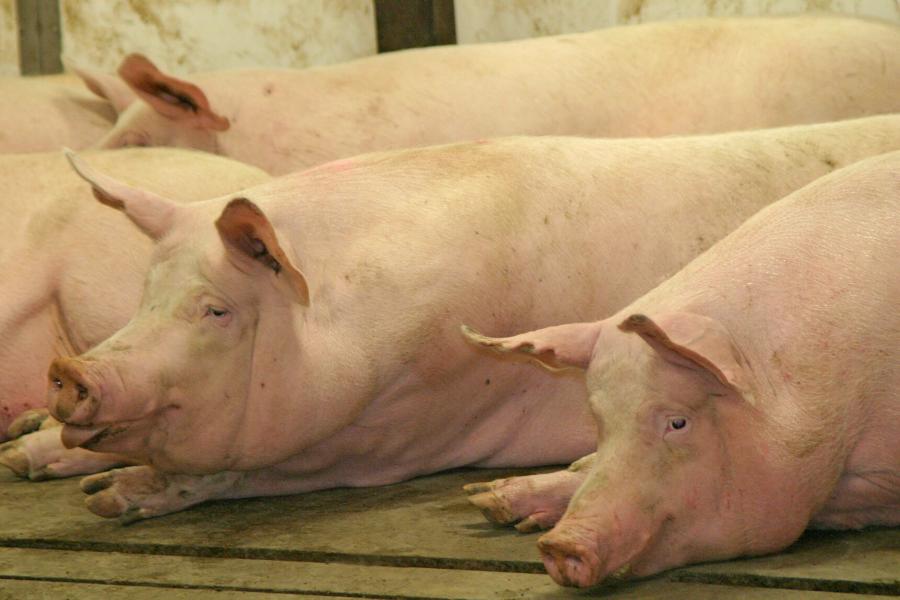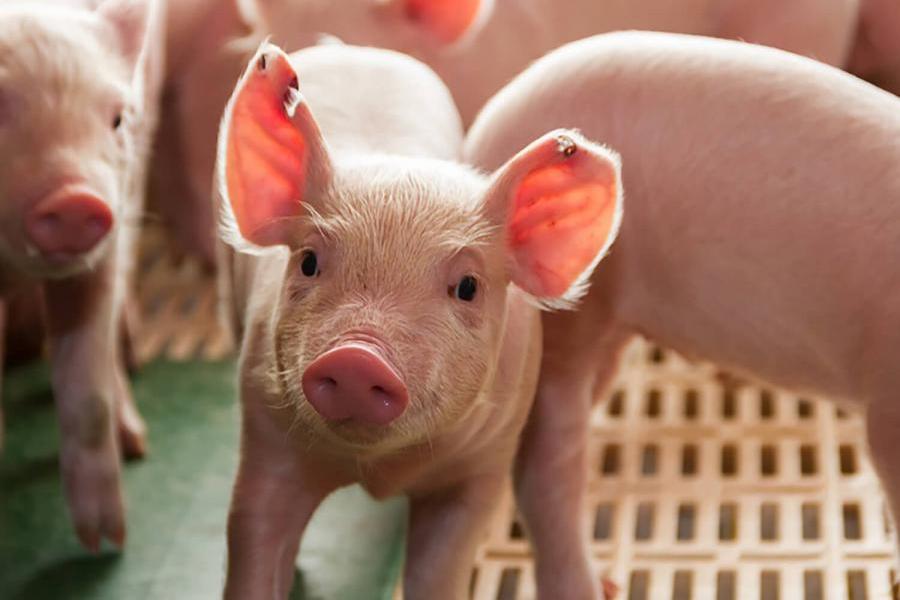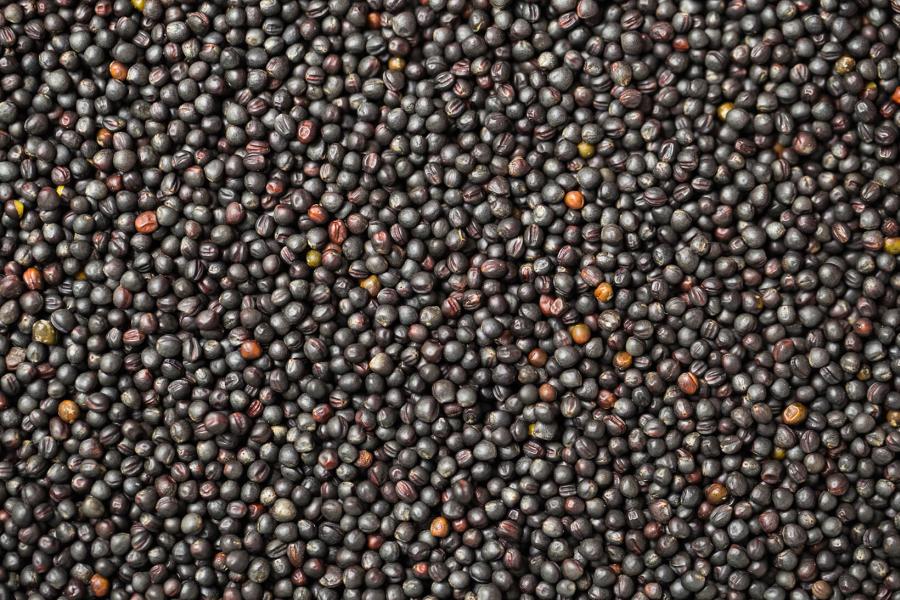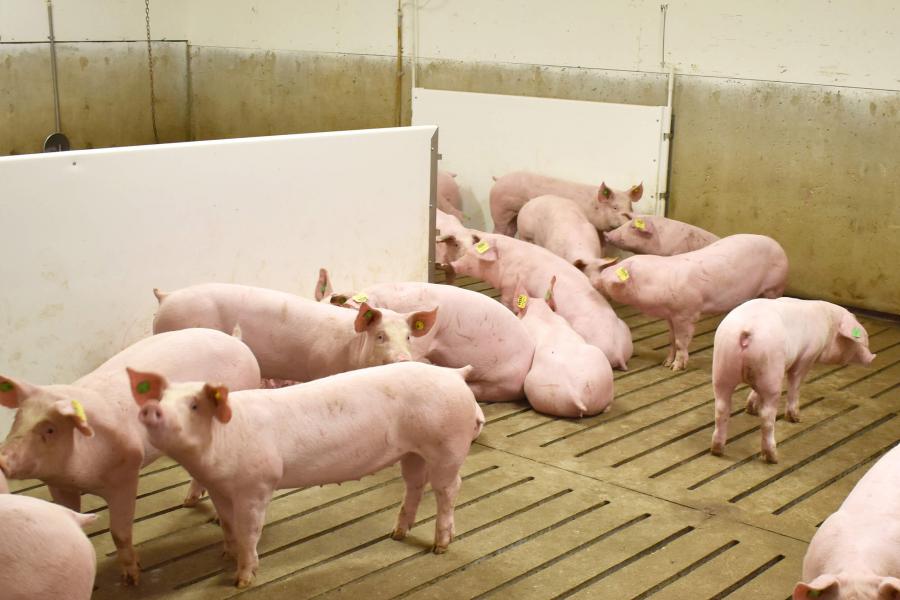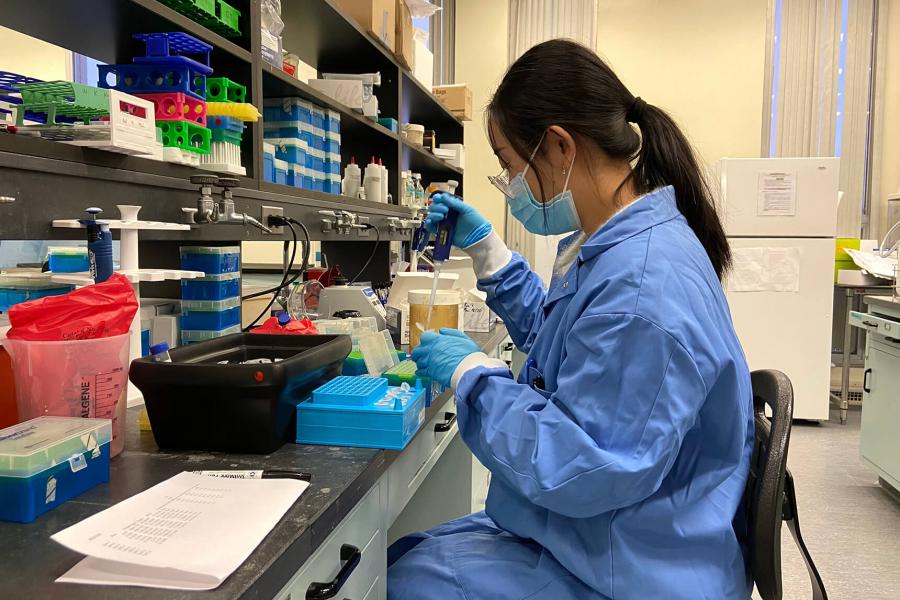One Health approaches to animal management
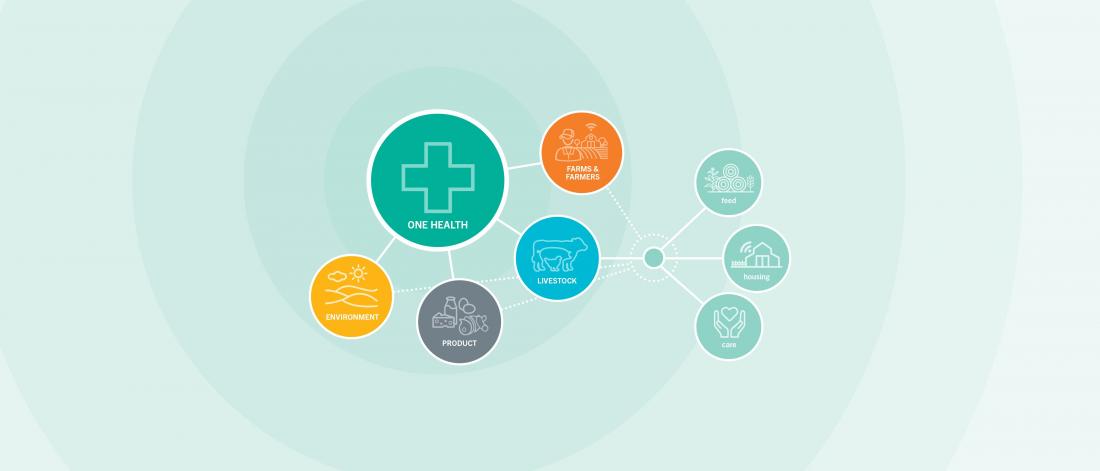
Making the connections between feed, care, housing and health
In the past, questions about the well-being of animals, the environment and the bottom line were mostly studied independently, in narrow disciplinary silos. But in recent years, there's been a growing recognition of the close and complex connections between these factors, and the need for solutions that support the health of all.
This approach – called One Health – is an important research principle of the National Centre for Livestock and the Environment. The One Health philosophy is shaping policies and practices in Canada and markets around the world. Through NCLE, the Canadian livestock sector is finding new and cost-effective ways to adapt.
A lot is at stake for farmers as they make these changes. That's why NCLE provides access to a diverse network of experts who can consider questions from many angles, plus specialized equipment and facilities for new forms of investigation.
With these resources, researchers here can do more than explore; they can transfer new knowledge into practical, real-life solutions for farmers. The NCLE approach extends from discovery in the lab to delivery in the field.
One Health areas of research
- Housing environments
- Feeding and nutrition strategies
- Alternative feedstuffs
- Antibiotic alternatives
- Animal/human nutrition connections
- Animal/human well-being connections
- Pest management
- Disease risk mitigation
Asking the big questions, seeing the big picture
Filling gaps in knowledge about group sow housing
The National Centre for Livestock and the Environment (NCLE) has played a key role in helping pork producers navigate several major changes coming to their sector. One of the first was the ongoing move toward group sow housing, which started at about the same time NCLE was formed.
At that time, housing sows in a more open environment wasn't a typical practice on Canadian farms. Producers had many complex questions about how to successfully make the transition, from sow health and social dynamics to how to determine the best barn layout. Finding the answers required a whole-system approach, sector-wide partnerships and input from many different areas of expertise. In short, it was the perfect challenge for the newly minted NCLE.
Read More
Over more than a decade, the combined efforts of many NCLE researchers and partners provided farmers with workshops, seminars and a well-stocked toolbox of information resources for moving to sow group housing, backed up by research conducted in real-world, Canadian conditions.
The first step: creating a new kind of whole-system research infrastructure
One of NCLE’s first tasks was to create new facilities for studying sows in groups. At Glenlea Research Station, in 2006 and 2007, new barns were built with special features, including systems allowing sows to be fed and monitored individually.
“It was probably the first research facility in Canada developed specifically for this purpose,” says Professor Laurie Connor, a pioneering researcher who led group sow housing studies at the University of Manitoba before retiring. “It allowed us to compare housing systems at a small farm scale, and as part of a whole-farm approach.”
Building the team approach
With Glenlea as their home base, Connor’s team gradually explored a full range of sow group housing questions in such areas as sow social dynamics incidence of lameness, management strategies and the importance of access to environmental enrichments. More disciplines became involved as the work progressed. Depending on the project focus, the research involved specialists in animal behaviour, economics, building materials and computer modelling. Strong support from groups like Manitoba Pork ensured the work was always aligned with the practical challenges faced by producers.
A suite of practical decision-making tools
Whether the focus was sow behaviour or barn materials, the ultimate goal of this research was to provide practical, accessible guidelines for a successful transition to group sow housing. In 2010, Connor, Zhang and Manitoba Pork teamed up with animal scientist Jane Goodridge, engineer David Wildeman and economist Gary Johnson to tackle this important challenge.
One of the first tools they developed was a computer program that allowed early adopters to explore how different conversion scenarios might play out in their own barns. Using the program, they could generate barn layouts, construction estimates and financial projections for different conversion options, customized to their farm’s unique situation.
The team then developed a guidebook covering all important considerations for converting to group sow housing in Manitoba. The guide was updated in 2018 with the latest science-backed information.
Better understanding of flooring
As they looked for critical knowledge gaps, the team soon noted many unexplored questions about flooring, which plays an important role in sow lameness and well-being in group housing systems. Slatted concrete is the most common flooring system in North American pig barns because it allows manure to drain through. However, research to determine the ideal slat-to-gap ratio for comfort, hygiene and air quality was lacking.
To find the answers, Connor teamed up with Qiang Zhang, a University of Manitoba professor and biosystems engineer with 30 years of experience studying animal environments. This led to one of Manitoba’s largest research projects related to sow group housing. The broad range of experts on the team included ethologists, engineers and Barkman Concrete, a leading barn flooring manufacturer, to ensure the test flooring matched real-life conditions.
The group considered a number of possible configurations for slatted flooring in the lab, and then scaled up the most promising configurations for testing in the Glenlea research barns. Floors with nine different slat-to-gap ratios were built on-site, and sows were then videotaped walking across the various flooring configurations.
The collaboration of Nicolas Devillers, an Agriculture and Agri-Food Canada researcher, made it possible to apply advanced techniques like kinematics to analyze the sows’ gaits, postures and overall behaviour. In this way, the team could spot the slat/gap ratios allowing for good sow movement, comfort and fewer injuries, without causing problems with manure drainage or hygiene. The most promising configuration was tested in-barn during two complete sow gestation periods.
Their conclusion: The ideal flooring configuration for comfort, hygiene and injury prevention is a slat width of 105 mm separated by a 19 mm gap. That’s significant because most North American flooring has wider slats, spaced farther apart. Because of this finding, the sector is now better equipped to improve the design of flooring for group housing situations in the future.
“The amount of concrete used is the same so there should be no impact on the cost,” Zhang points out. “How that concrete is configured is what makes the difference.”
Planting seeds for ongoing research and improvements
Today the legacy of sow group housing research at Glenlea lives on. The findings have influenced Codes of Practice for the pork sector and provided important building blocks for the National Sow Housing Conversion Project.
Former graduate students who worked on these studies are now using their experiences to advance on-farm practices as agri-business leaders, researchers and producers themselves. Research collaborators have picked up the baton and are carrying the work forward.
“What we’ve started here has seeded the work now underway,” Connor says. “We were able to be the catalyst because we were able to do the teamwork here, and in very unique facilities. Now the knowledge can grow even more.”
Research team
Scientists:
Laurie Connor (PI), Animal Science, University of Manitoba
Nicolas Devillers (Co-PI), Agriculture and Agri-Food Canada - Sherbrooke
Jennifer Brown, Prairie Swine Centre and University of Saskatchewan
Qiang Zhang (Co-PI), Biosystems Engineering, University of Manitoba
Kristopher Dick, Biosystems Engineering, University of Manitoba
Gary Johnson, Agribusiness and Agricultural Economics, University of Manitoba
Derek Brewin, Agribusiness and Agricultural Economics, University of Manitoba
Harold Gonyou, Prairie Swine Centre and University of Saskatchewan
Renée Bergeron, Animal Science, University of Guelph
Project postdoctoral fellows/research associates (PhD) and their current positions:
Yolande Seddon, NSERC Industrial Chair in Swine Welfare/Assistant Professor Swine Behaviour and Welfare at WCVM
Sabine Conte, Postdoctoral Research Scientist Animal Behaviour and Welfare, AAFC Sherbrooke
Farhoud Delijani, Price Faculty of Engineering, University of Manitoba
Cyril Roy, Prairie Swine Centre
Fiona Lang, Prairie Swine Centre
Graduate students (now completed):
Xiaojie (Emily) Yan (PhD)
Emmanuel Janvier (MSc)
Millie Lemieux (MSc)
Victoria Kyeiwaa (MSc)
Funders and partners
- Manitoba Pork
- Swine Innovation Porc
- Sask Pork
- Alberta Pork
- Agriculture and Agri-Food Canada
- Manitoba Rural Adaptation Council
- Genesus Genetics
- Barkman Concrete
- Faculty of Agricultural and Food Sciences, University of Manitoba
Resources
Website: National Sow Housing Conversion Project
Guidebook: Options for successful group housing of sows
Training manual: Housing sows in groups
Article: National Hog Farmer (2018) - Enriching Sows’ positive behaviour
Article: Canadian Hog Journal (2018) - Optimizing concrete slat and gap widths for group-housed gestating sows. pp 24-29.
Article: Better Pork (2018) - Avoiding sow injuries
London Swine Conference (2014)
- Group Sow Housing - the Facts. Proceedings of the London Swine Conference: Position for Success. pp 7-18.
- Success with Group Housing. pp 29-34.
National Pork Board (2013) - Group Housing Systems – Choices and Designs
Scientific publications
- Effects of enrichment type, presentation and social status on enrichment use and behaviour of sows with electronic sow feeding
- Effect of slat and gap width of slatted concrete flooring on sow gait using kinematics analysis
- Determining an effective slat and gap width of flooring for group sow housing, considering both sow comfort and ease of manure management
- In-barn measurements of surface roughness and friction of slatted concrete floor in sow gestation rooms
- Use of an analgesic to identify pain-related indicators of lameness in sows
- Measure and characterization of lameness in gestating sows using force plate, kinematic, and accelerometer methods
Providing the livestock sector with antibiotic alternatives
As the Canadian livestock sector reduces use of antibiotics, farmers are looking for other ways to maintain animal health. Scientists have identified many promising disease-fighting alternatives, including bioactives derived from such diverse sources as egg yolks, yeast culture, essential oils, organic acids, probiotics and prebiotics.
One challenge of using antibiotic alternatives is finding practical ways to deliver them to livestock through feed and water supplies. Those questions are now being answered by researchers associated with the National Centre for Livestock and the Environment (NCLE).
Read more
Among the researchers looking for solutions is Dr. Chengbo Yang, an associate professor in livestock nutrition at the University of Manitoba. His recent successes are related to processes for incorporating essential oils into animal feed.
Yang is currently focused on a technique called microencapsulation, which feed companies are already using to deliver various kinds of beneficial compounds through feed. The technique encases essential oils in larger molecules, which keeps the bioactives protected, stable and potent as feed is manufactured and then digested in the stomachs of animals. This allows the antimicrobials to reach the right parts of the animal’s digestive system so they can provide maximum benefit. The process also masks the taste of essential oils and other additives, ensuring the feed remains palatable.
In collaboration with commercial partners, Yang has been evaluating the effectiveness of existing microencapsulation methods, while also exploring development of new processes. His team is developing an alternative technique using granulation, which may allow additives to be introduced more economically during feed manufacturing. All of the ingredients used in their new process have already been approved for use in the feed industry, so it aligns well with regulatory requirements.
The team has tried out the new technique by microencapsulating thymol, an essential oil derived from thyme. Thymol is one of several compounds showing great potential to maintain gut health and pig performance – provided a large portion of the bioactives can move past the stomach, to the lower intestine, as the animal digests the treated feed.
Trials done by Yang’s team with weaned piglets have shown that thymol can be delivered effectively using both commercially available microencapsulation products and the team’s new granulation method. Commercial use of the team’s new granulation method may not be far away. A patent is now in place, and several international suppliers have already shown interest.
Yang says that the combined expertise of the research team is a big factor in the project’s success. The work is being conducted in collaboration with a commercial feed additive manufacturer, a food processing partner and a multi-disciplinary team of experts, including a chemist, polymer scientist and microbiologist.
"As a nutritionist, I'm well-acquainted with the farmer's practical needs and challenges related to animal health, but it takes a different kind of knowledge to select the right ingredients to make a stable microparticle," he says. "That's why I invited scientists from other disciplines to join the team. The microbiologist helped us select bioactives with strong antimicrobial properties and synergistic interactions, and the polymer scientist and chemist figured out how to formulate it all."
Yang hopes this project will be a gateway to more collaborative work with the industry. He plans to carry out more research aimed at understanding and improving existing technologies and developing innovative ways to protect and deliver new bioactives ingredients. For instance, he thinks emulsification of bioactives into the water supply could be another promising solution – particularly in the poultry sector, which is also challenged by the phase-out of preventive antibiotics.
"I think we already have the solutions for replacing antibiotics," says Yang. "Now the questions are about how we maximize the value of these alternatives by improving effectiveness and bringing down costs. That’s where researchers need to focus as we move forward."
Research team
Scientists:
Chengbo Yang (PI), Animal Science, University of Manitoba
Martin Nyachoti, Animal Science, University of Manitoba
Song Liu, Biosystems Engineering, University of Manitoba
Joshua Gong, Agriculture and Agri-Food Canada
Qi Wang, Agriculture and Agri-Food Canada
Graduate students:
Faith Omonijo, MSc
Janghan Choi, Msc
Qianru Hui, PhD Xiaoya Zhao, PhD
Postdoctoral fellow:
Peng Lu
Funders and partners
NSERC
Jefo Nutrition Inc.
Manitoba Pork
Canada Foundation for Innovation (CFI)
Graduate Enhancement of Tri-council Stipends (GETs) Program, University of Manitoba
Resources
Fact sheet: Optimizing gut health for swine in antibiotic free production
Webinar: The microbiota concept on swine production: A overview from the past to the future
Article: The role of essential oils in gut health
Article: Essential oils blend shows promise as antibiotic alternative
Article: Lipid matrix allows for thymol delivery in weaned pigs
Article: Organic acid, essential oil blend may boost chicken efficiency, immune function
Scientific publications
- Eugenol attenuates inflammatory responses and enhance barrier functions during lipopolysaccharide (LPS)-induced inflammation in porcine intestinal epithelial (IPEC-J2) cells
- Effects of a microencapsulated formula of organic acids and essential oils on nutrient absorption, immunity, gut barrier function, and abundance of enterotoxigenic Escherichia coli F4 in weaned piglets challenged with E. coli F4
- Thymol improves barrier function and attenuates inflammatory responses in porcine intestinal epithelial cells during lipopolysaccharide (LPS)-induced inflammation
- Development of novel microparticles for effective delivery of thymol and lauric acid to pig intestinal tract
- Innovative drugs, chemicals, and enzymes within the animal production chain
- Essential oils as alternatives to antibiotics in swine production
- Capsaicin attenuates inflammation and improves barrier function in lipopolysaccharide-challenged porcine intestinal epithelial cells
Exploring how feed sources align with One Health goals
Farmers have always known that diet makes a big difference to animal performance and profitability. Less well understood is how feed choices can affect other aspects of commercial livestock operations, like animal wellness, environmental impact and effects on workers and neighbours.
Connecting the dots between livestock diets and these larger considerations is a priority of animal nutritionists affiliated with the National Centre of Livestock and the Environment (NCLE). As they evaluate the nutritional value of feedstuffs, they also look at the functional benefits, which can range from warding off illness to reducing output of undesirable odours and greenhouse gases.
Read more
Their work is focused on the growing range of feed ingredients that are produced locally, including many that the local livestock sector is just discovering.
Here are some examples of how scientists are demonstrating the important role of feed in the sustainability of the Western Canadian livestock sector.
Canola meal: revealing additional advantages for swine operations
At the University of Manitoba, much of this research is led by Martin Nyachoti, head of the Animal Science department in the Faculty of Agricultural and Food Sciences. Nyachoti is one of the most widely cited researchers of swine diets worldwide, and has conducted feed trials on a huge range of locally available feed sources, from the familiar to the more unusual.
One of the feedstuffs studied extensively by Nyachoti is canola meal, a feedstuff widely available in the Prairies, which is the world’s leading region for canola production. His team’s research has helped correct misconceptions about feeding canola meal to swine and other livestock, helping producers incorporate larger proportions into animal diets with good results.
At the same time, Nyachoti and colleagues have shown that canola meal provides additional advantages beyond basic nutrition. For example, they have found that canola meal can provide a health boost to young pigs in the critical post-weaning period. Although they don’t yet fully understand why it happens, they have observed that canola meal has a positive effect on the gut microbiome.
“We think the higher fibre content of canola meal may be the reason,” Nyachoti says. “One member of the team has speculated that canola fibre may have a prebiotic effect in the gut, but we’ll need to dig a little deeper to determine whether that’s the case.”
They’ve also found that canola meal’s higher fibre level can generate other important benefits, including better air quality in pig barns. As Nyachoti explains, dietary fibre causes changes in the gut, resulting in fewer odour-causing compounds. It also redirects nitrogen to the pigs’ feces, rather than urine. The end result is less odour and ammonia, and improved air quality for the pigs and the people working alongside them.
Most importantly for farmers, the team’s feed trials have shown that canola meal is both good for pigs and for the bottom line. Canola meal has an excellent amino acid profile for pigs and produces results comparable to more expensive protein sources.
“Sows will eat a lot of it, and that’s very important during lactation, when they are encouraged to eat as much as possible to produce milk for the piglets,” says Nyachoti.
DESBM: shedding light on the advantages of soybean heat-processing
Nyachoti’s team also looks at how local processing methods affect the nutritional and functional value of common feed ingredients. Occasionally, these feed trials reveal previously unknown benefits for animal health. One example is their recent research into the particular type of soybean meal produced locally.
Much is known about conventionally processed soybean meal, which is by far the most common protein source for livestock rations throughout the world. However, soybeans are a relatively new crop on the Canadian prairies and are processed differently, due to the lack of soybean processing plants in new growing areas. Here, small-scale processors typically heat and press soybeans to separate oil and meal, rather than using the usual solvent extraction process. The resulting product is called DESBM (dry extruded-expelled soybean meal).
To help local livestock producers make best use of this local protein source, Nyachoti and colleague Chengbo Yang decided to take a closer look at DESBM’s nutritional value. What they observed were important advantages resulting from the heat-processing method.
One significant finding was that heat processing soybeans seems to help pigs digest phosphorus. In this way, DESBM may provide pigs with better access to an essential nutrient while helping to control phosphorus build-up in the surrounding environment. The team also found impressive advantages in the nutrient content, including 12% higher energy content compared to solvent-extracted soybeans.
With this new data, local farmers and nutritionists can formulate animal diets with confidence, knowing that they are making the best use of this local protein source.
Red osier dogwood: finding medicinal value in native plants
Another avenue of exploration for Nyachoti and his colleagues is antibiotic alternatives for use in livestock feed. The team evaluates the viability of medicinal ingredients from many sources, including the wild plants growing all around us.
One of these promising alternatives is red osier dogwood, a plant that thrives in many parts of Manitoba. Studies here have shown that the ground leaves and bark of these shrubs can help prevent E.coli infections, which are an important source of disease in piglets and poultry.
“It has a high level of the compounds that have a positive effect,” says Nyachoti, “For many years, a local company has been producing supplements from red osier dogwood for human health, and they would very much like to do the same thing for pigs.”
Feed ingredient database: providing knowledge for practical use
For every feed source studied, the ultimate goal is to take the guesswork out of using unfamiliar feed ingredients, including alternative sources that reduce waste and strengthen the One Health approach to animal management.
Findings from feed trials are catalogued in a constantly growing database, which farmers and nutritionists can access to formulate well-balanced livestock diets. Today the database includes soybeans, low-fat corn, faba beans and chickpeas, or underused by-products that cannot be consumed by humans, like the hulls and other so-called “waste” from crops like oats, hemp and camelina.
Research team
Scientists:
Martin Nyachoti (PI), Animal Science, University of Manitoba
Bogdan Slominski, Animal Science, University of Manitoba
Chengbo Yang, Animal Science, University of Manitoba
Karmin O, Animal Science, University of Manitoba
Graduate students:
Jichen Song, PhD
Bonjin Koo, PhD
Postdoctoral fellow:
Alemu Hunde
Funders and partners
- Manitoba Pork
- Swine Innovation Porc
- Canola Council of Canada
- Agriculture and Agri-Food Canada
- Manitoba Agriculture
Resources
Scientific publications
View publications by Martin Nyachoti on Google Scholar

